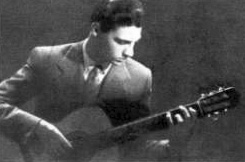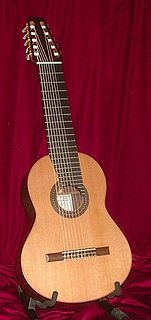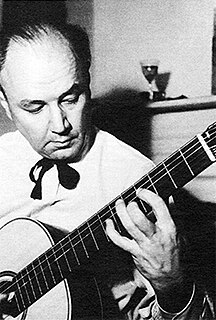
A guitar pick is a plectrum used for guitars. Picks are generally made of one uniform material—such as some kind of plastic, rubber, felt, tortoiseshell, wood, metal, glass, tagua, or stone. They are often shaped in an acute isosceles triangle with the two equal corners rounded and the third corner less rounded. They are used to strum chords or to sound individual notes on a guitar.

The seven-string guitar adds one additional string to the more common six-string guitar, commonly used to extend the bass range or also to extend the treble range.

Fingerstyle guitar is the technique of playing the guitar by plucking the strings directly with the fingertips, fingernails, or picks attached to fingers, as opposed to flatpicking. The term "fingerstyle" is something of a misnomer, since it is present in several different genres and styles of music—but mostly, because it involves a completely different technique, not just a "style" of playing, especially for the guitarist's picking/plucking hand. The term is often used synonymously with fingerpicking except in classical guitar circles, although fingerpicking can also refer to a specific tradition of folk, blues and country guitar playing in the US. The terms "fingerstyle" and "fingerpicking" also applied to similar string instruments such as the banjo.
D'Addario is a manufacturer of musical instrument strings and accessories, primarily for guitars but also many other fretted and orchestral instruments. The company currently has its world headquarters in Farmingdale, Long Island, New York, and its European headquarters in Newcastle upon Tyne, Tyne and Wear, England. It is a family-owned and operated business that is one of the largest string manufacturers in the world, not only producing several lines of strings under their own brand names, but also making OEM strings for other musical instrument companies.

The Russian guitar (sometimes referred to as a "Gypsy guitar") is an acoustic seven-string guitar that was developed in Russia toward the end of the 18th century: it shares most of its organological features with the Spanish guitar, although some historians insist on English guitar ascendancy. It is known in Russian as the semistrunnaya gitara (семиструнная гитара), or affectionately as the semistrunka (семиструнка), which translates to "seven-stringer". These guitars are most commonly tuned to an open G chord as follows: D2 G2 B2 D3 G3 B3 D4. In classical literature, the lowest string (D) occasionally is tuned down to the C.

A string is the vibrating element that produces sound in string instruments such as the guitar, harp, piano, and members of the violin family. Strings are lengths of a flexible material that a musical instrument holds under tension so that they can vibrate freely, but controllably. Strings may be "plain", consisting only of a single material, like steel, nylon, or gut, or wound, having a "core" of one material and an overwinding of another. This is to make the string vibrate at the desired pitch, while maintaining a low profile and sufficient flexibility for playability.
Eliot Hamilton Fisk is an American classical guitarist.

Ramírez Guitars is a Spanish manufacturer of professional, concert-quality classical and flamenco guitars. Five generations of the Ramírez family have produced Ramirez guitars.
Finger vibrato is vibrato produced on a string instrument by cyclic hand movements. Despite the name, normally the entire hand moves, and sometimes the entire upper arm. It can also refer to vibrato on some woodwind instruments, achieved by lowering one or more fingers over one of the uncovered holes in a trill-like manner. This flattens the note periodically creating the vibrato.
In classical guitar, the right hand is developed in such a way that it can sustain two, three, and four voice harmonies while also paying special attention to tone production. The index (i), middle (m), and ring (a) fingers are generally used to play the melody, while the thumb (p) accompanies in the bass register adding harmony, and produces a comparable texture and effect to that of the piano. The classical guitar is one of the very few solo polyphonic instruments, and is notoriously difficult to master.

A flamenco guitar is a guitar similar to a classical guitar but with thinner tops and less internal bracing. It is used in toque, the guitar-playing part of the art of flamenco.
Classical guitar strings are strings manufactured for use on classical guitars. While steel-string acoustic guitar strings and electric guitar strings are made of metal, modern classical guitar strings are made of nylon and nylon wound with wire, which produces a different sound to the metal strings. Classical guitar strings were originally made with animal intestine and silk wound with animal intestine up until World War II, when war restrictions led Albert Augustine Ltd. to develop nylon strings. Nylon guitar strings were put into production in 1948. Strings made from fluorocarbon polymers have since been developed and are the main alternative to nylon strings.

José Tomás Pérez Sellés was a Spanish classical guitarist and teacher. Considered a major influence on the evolution of classical guitar technique in the second half of the 20th century, he trained many guitarists from all over the world.

There are many varieties of ten-string guitar, including:

The ten string extended-range classical guitar, with fully chromatic, sympathetic string resonance was conceived in 1963 by Narciso Yepes, and constructed by José Ramírez [III]. This instrument is sometimes referred to as the "modern" 10-string guitar to differentiate it from ten-stringed harp guitars of the 19th century.



















